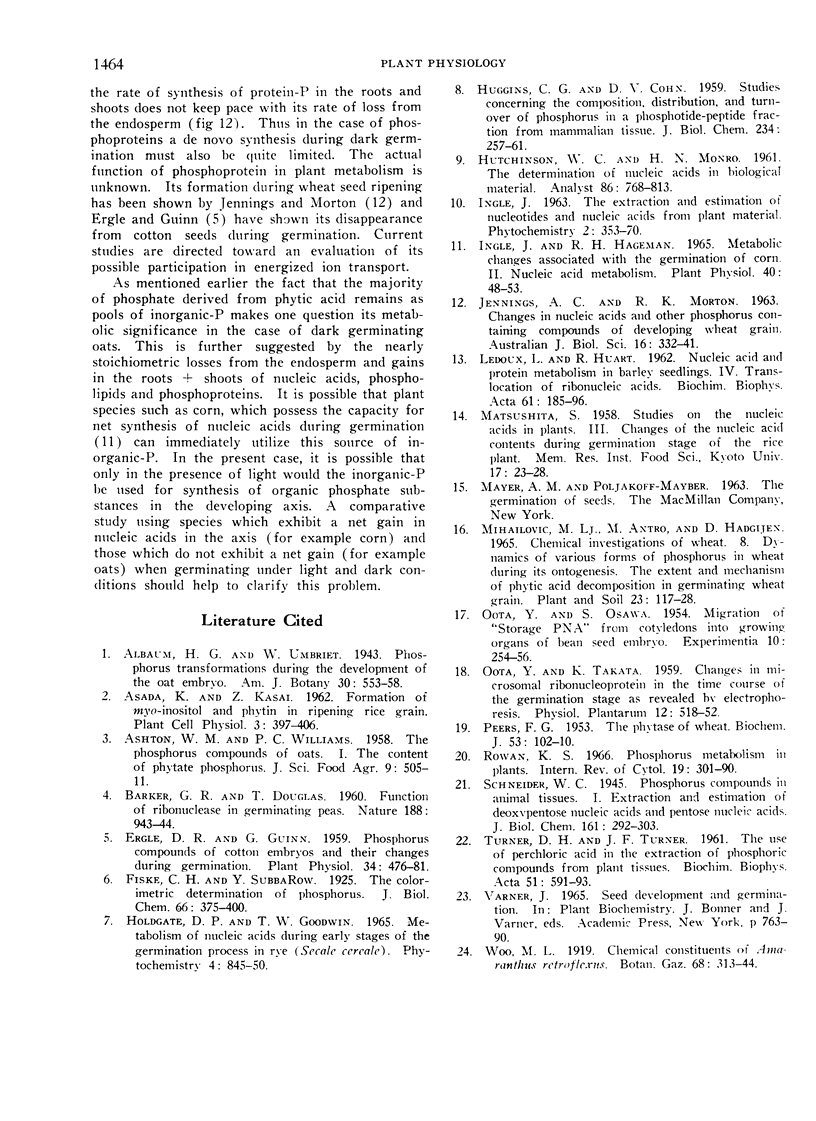Abstract
An investigation has been made of the changes in the major phosphorus containing substances in Avena sativa during the first 8 days of dark germination. The endosperm, roots, and shoots were analyzed separately for acid soluble-P, phytic acid-P, inorganic-P, lipid-P, nucleic acid-P, and protein-P. Phytic acid-P comprised 53% of the total seed phosphate, while the sum of lipid-P, nucleic acid-P and protein-P comprised 27% of the seed phosphate. All these reserve phosphate materials were mobilized and transferred to the developing axis. The phosphate from phytic acid appeared almost entirely as inorganic-P in the roots and shoots. A close stoichiometry existed between the rate of loss of nucleic acid-P from the endosperm and its rate of appearance in the roots and shoots. Thus no net synthesis of nucleic acid occurred during the 8-day period examined. The rate of synthesis of lipid-P in the roots and shoots exceeded its rate of disappearance from the endosperm during the first 4 days of germination. Protein-P increased in the roots and shoots during germination, but at a rate less than its rate of disappearance from the endosperm. The results provide a relatively complete description of the over-all aspects of phosphorus metabolism associated with germination of oats.
Full text
PDF





Selected References
These references are in PubMed. This may not be the complete list of references from this article.
- Ergle D. R., Guinn G. Phosphorus Compounds of Cotton Embryos and Their Changes during Germination. Plant Physiol. 1959 Jul;34(4):476–481. doi: 10.1104/pp.34.4.476. [DOI] [PMC free article] [PubMed] [Google Scholar]
- HUGGINS C. G., COHN D. V. Studies concerning the composition, distribution, and turnover of phosphorus in a phosphatido-peptide fraction from mammalian tissue. J Biol Chem. 1959 Feb;234(2):257–261. [PubMed] [Google Scholar]
- Ingle J., Hageman R. H. Metabolic changes associated with the germination of corn. II. Nucleic acid metabolism. Plant Physiol. 1965 Jan;40(1):48–53. doi: 10.1104/pp.40.1.48. [DOI] [PMC free article] [PubMed] [Google Scholar]
- LEDOUX L., HUART R. Nucleic acids and protein metabolism in barley seedlings. IV. Translocation of ribonucleic acids. Biochim Biophys Acta. 1962 Aug 20;61:185–196. doi: 10.1016/0926-6550(62)90081-6. [DOI] [PubMed] [Google Scholar]
- PEERS F. G. The phytase of wheat. Biochem J. 1953 Jan;53(1):102–110. doi: 10.1042/bj0530102. [DOI] [PMC free article] [PubMed] [Google Scholar]
- TURNER D. H., TURNER J. F. The use of perchloric acid in the extraction of phosphoric compounds from plant tissues. Biochim Biophys Acta. 1961 Aug 19;51:591–593. doi: 10.1016/0006-3002(61)90621-7. [DOI] [PubMed] [Google Scholar]


